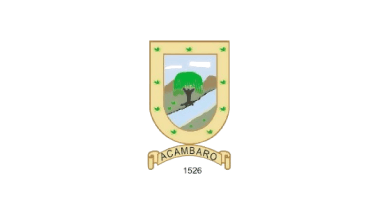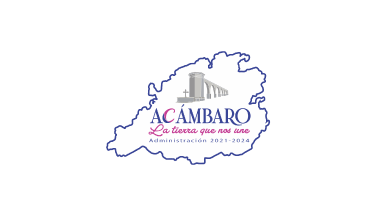
by Daniel Rentería, 2 July 2025, using coat of arms at guanajuato.gob.mx
image: [1] from Facebook

Last modified: 2025-07-18 by daniel rentería
Keywords: acambaro | guanajuato | bandera municipal y escudo municipal (guanajuato) | escudo del municipio (guanajuato) | bandera del municipio (guanajuato) | héraldica municipal de guanajuato |
Links: FOTW homepage |
search |
disclaimer and copyright |
write us |
mirrors

by Daniel Rentería, 2 July 2025, using coat of arms at guanajuato.gob.mx
image: [1] from Facebook
See also:
The flag of Acámbaro is white with its coat of arms centered upon it.
Daniel Rentería, 2 July 2025

flag photo from Facebook
.gif)
from Wikimedia Commons
According to the book Acámbaro: el maguey, el escudo, sus leyendas: there was possibly a coat of arms from 1734. The current coat of arms was recognized through a popular vote in December 1944, created by José Ríos Velarde for the Coronation of the Virgin of the Refuge. It was sculpted into the St. Francis of Assisi Temple. Although it was replaced by the official adoption of a coat of arms in March 1987, it received official status in March 1998 under the term of Municipal President José Ignacio Nares Luna (1998-2000). Description according to the book:
In the visual field, appear clouds (sign of abundant rain), the two Cerro del Chivo and Cerro del Toro hills, a leafy and giant cypress at the edge of the Lerma River whose cause flows from east to west and finishing, two grassland fields dedicated to the sowing of grains. All of the aforementioned surrounded by an upright frame in its top and circular in its bottom, in whose center 9 agave plants are drawn, which represent the authorities; cutting the Shield from the middle of the top to bottom, the 4 agave plants to the north side represent the Otomí (chichimeca) Indians and of the lower side, represent the authority of Purépecha chiefs. The agave plants are allusive to the fact that Acámbaro means "Place of Agave Plants" in Tarascan tongue, and the central agave plant in the upper part represents the founder Don Nicolás de San Luis Montañés. Finally, the shield ends with a sign in threaded parchment, with the name in manually written letters, with the legend of Acámbaro, furthermore the year of 1526 [under], its year of foundation.
Daniel Rentería, 2 July 2025
On 27 March 1987, the Municipal Council adopted a design by painter J. Jesús Gutiérrez Flores (originally of San Luis Potosí), being adopted through a contest held by the Municipal Council under Municipal President Daniel Narváez Mancera (1986-1988). Description from the designer:
The Shield, quartered in cross with sections in silver (white), simulating the principal characteristics of the acambarenses. Integrity, firmness. In the first section, it alludes to the historic past of the municipality. A figure of indigenous artisanry is appreciated in his natural color, belonging to one of the oldest pre-Hispanic cultures of America which flourished in this region and whose influence reached the Mesoamerican cultures: The Chupícuaro Culture. In the second field of the shield, an indigenous feather-hat is highlighted with azure (blue) feather and gules (red), accompanied by an open book with manually written characters of white pages and binded in parchment. This form represents the fusion of two cultures and races; the loyalty and fight of the fatherland in valor and unity, with the azure and gules of the feathers as importance in education and culture collectively in the open book for all. In the third section the Bridge of Stone from the 18th century is carried, with a tree of vert (green) to its dexer side, joined reflecting the transcendence of the named River in the history and economy of the municipality; the permanence of our colonial monuments including the Bridge, these as symbol of security in difficult ventures; and in the rooting of the town to its land, represented by the Cypress greatly rooted. In the fourth field, (it has) a locomotive of train tracks summed with various wagons, its tail being over rails and placed in the form of a bar, which alludes to the importance of Acámbaro as railroading center at the national level. In the inescutcheon, the Father of the Fatherland is reproduced, Don Miguel Hidalgo y Costilla, presented with the upper part of his body and characterized by his militaristic attributes of Generalissimo, grade which he received in the Liberator Army by the commandant on 22 October 1810, in this place. The aforementioned shield carries a border of vert (green), the same of which is divided into sections and frames the inescutcheon, signifying the hope for a better future, the abundance of positive values, and the participation of Acámbaro in our liberating fights. The Shield is placed in a card or yellow-gold cartridge to exalt the dignity and nobility of the town, of land and acambarense ideals, carrying in each ones of its flanks as supports a cob of corn adorned with leaves that form a wreath to symbolize agriculture, fundamental entry for the economy of the municipality. Over the Shield, in the form of crest, an agave plant of sinople (vert) supports it which evokes the significance of the name of Acámbaro in the Tarascan tongue as "Place of Agave Plants". Accompanying the mentioned agave, both breads in their natural color, justifying the fame of this product in the entire country and further than our boundaries. Additionally, the municipal government added in the upper scroll of the Shield, the year 1526, remembering the year of Foundation of Acámbaro and the legend: "With Acámbaro Guanajuato Was Born", inscribed in sable (black) letters over a ribbon of silver (white) to the foot of the proper Shield. The phrase corresponds to the year 1824, when Acámbaro acquired by deed the status of Villa. In the lower scroll, also in sable (black) letters, is the inscription: "Municipio Libre", consecrated category constitutionally and through which allegorically symbolizes the traditional colors of the Municipality: The vert (green) and the gold (yellow). Both colors are predominant in the Shield.
Daniel Rentería, 2 July 2025
Anything below this line was not added by the editor of this page.